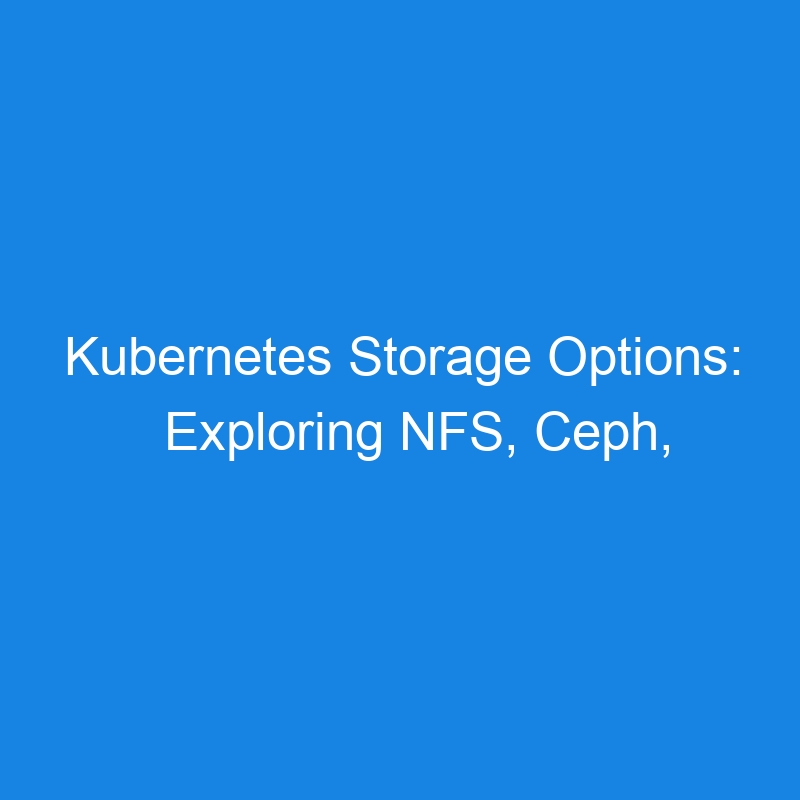Kubernetes Storage Options: NFS, Ceph, GlusterFS, EBS
Kubernetes supports various storage systems to provide persistent storage for applications. These storage options enable Kubernetes to manage stateful workloads effectively. Each option has unique characteristics, making it suitable for specific use cases.
In this article, we will discuss four popular storage options in Kubernetes: NFS, Ceph, GlusterFS, and EBS. We’ll explore their features, use cases, and how they integrate with Kubernetes.
1. Network File System (NFS)
NFS is a distributed file system protocol that allows a server to share directories with clients over a network. Kubernetes supports NFS as a storage option, making it a good choice for shared storage across Pods.
Key Features:
- Shared Access: Multiple Pods can read/write data concurrently.
- Simplicity: Easy to set up and manage.
- Compatibility: Works with most Kubernetes distributions.
Use Cases:
- Shared storage for web servers.
- Centralized storage for log aggregation.
- Storage for test or development environments.
How to Use NFS in Kubernetes:
- Set up an NFS server.
- Create a PersistentVolume (PV) that points to the NFS server.
- Create a PersistentVolumeClaim (PVC) to request the storage.
Example: Configuring NFS Storage
apiVersion: v1
kind: PersistentVolume
metadata:
name: nfs-pv
spec:
capacity:
storage: 10Gi
accessModes:
- ReadWriteMany
nfs:
server: 192.168.1.100
path: /shared
---
apiVersion: v1
kind: PersistentVolumeClaim
metadata:
name: nfs-pvc
spec:
accessModes:
- ReadWriteMany
resources:
requests:
storage: 10Gi
2. Ceph
Ceph is a distributed storage system that provides object, block, and file storage. Kubernetes integrates with Ceph through Rook, an open-source storage orchestrator.
Key Features:
- Scalability: Ceph scales horizontally by adding more storage nodes.
- Flexibility: Supports block storage (RBD), object storage (RGW), and file storage (CephFS).
- Fault Tolerance: Data replication ensures high availability.
Use Cases:
- Storage for cloud-native applications.
- High-performance databases.
- Workloads requiring high availability.
How to Use Ceph in Kubernetes:
- Deploy a Ceph cluster using Rook.
- Create a StorageClass for Ceph.
- Use the StorageClass in your PVC.
Example: Ceph StorageClass
apiVersion: storage.k8s.io/v1
kind: StorageClass
metadata:
name: ceph-block
provisioner: rook-ceph.rbd.csi.ceph.com
parameters:
clusterID: rook-ceph
pool: replicapool
imageFeatures: layering
3. GlusterFS
GlusterFS is a scalable, distributed file system that aggregates disk storage resources from multiple servers. Kubernetes can use GlusterFS for persistent storage.
Key Features:
- Distributed Storage: Combines multiple storage nodes into a single volume.
- Elastic Scalability: Easily add storage without downtime.
- High Availability: Replication across nodes ensures fault tolerance.
Use Cases:
- Media streaming applications.
- Large-scale data analytics.
- Workloads requiring scalable shared storage.
How to Use GlusterFS in Kubernetes:
- Set up a GlusterFS cluster.
- Create a PV that references the GlusterFS volume.
- Bind the PV to a PVC.
Example: Configuring GlusterFS
apiVersion: v1
kind: PersistentVolume
metadata:
name: gluster-pv
spec:
capacity:
storage: 20Gi
accessModes:
- ReadWriteMany
glusterfs:
endpoints: gluster-cluster
path: volume1
---
apiVersion: v1
kind: PersistentVolumeClaim
metadata:
name: gluster-pvc
spec:
accessModes:
- ReadWriteMany
resources:
requests:
storage: 20Gi
4. Amazon Elastic Block Store (EBS)
Amazon EBS is a block storage service provided by AWS. Kubernetes integrates with EBS to provide persistent storage for applications running in an AWS environment.
Key Features:
- High Performance: Designed for low-latency and high-throughput workloads.
- Durability: Data is replicated within an Availability Zone.
- Integration: Seamlessly integrates with Kubernetes via the AWS EBS CSI driver.
Use Cases:
- Databases like MySQL and PostgreSQL.
- Stateful applications running in AWS.
- Applications requiring high IOPS.
How to Use EBS in Kubernetes:
- Install the AWS EBS CSI driver.
- Create a StorageClass for EBS.
- Use the StorageClass in your PVC.
Example: EBS StorageClass
apiVersion: storage.k8s.io/v1
kind: StorageClass
metadata:
name: ebs-sc
provisioner: ebs.csi.aws.com
parameters:
type: gp2
fsType: ext4
Comparison of Storage Options
| Feature | NFS | Ceph | GlusterFS | Amazon EBS |
|---|---|---|---|---|
| Type | File | Block/File/Object | File | Block |
| Scalability | Limited | High | High | Limited to AZ |
| Access Modes | ReadWriteMany | All | ReadWriteMany | ReadWriteOnce |
| Cloud-Native | On-premises | Cloud/on-premises | Cloud/on-premises | AWS-specific |
| Performance | Moderate | High | High | High |
| Setup Complexity | Simple | Complex (via Rook) | Moderate | Simple (AWS only) |
| Use Cases | Shared storage | High availability | Media, analytics | AWS workloads |
Best Practices for Choosing a Storage Option
- Understand Your Workload: Match the storage type to your application needs (e.g., block for databases, file for shared storage).
- Consider Scalability: Use solutions like Ceph or GlusterFS for large-scale deployments.
- Leverage Cloud-Native Solutions: Use cloud-native storage like EBS for applications hosted in specific cloud environments.
- Evaluate Performance Requirements: Choose storage options based on IOPS and throughput needs.
Conclusion
Kubernetes supports a wide range of storage options to cater to different application requirements. Whether you need shared storage with NFS, highly scalable storage with Ceph or GlusterFS, or cloud-native block storage with AWS EBS, Kubernetes provides the flexibility to integrate and manage these storage systems seamlessly.
Choosing the right storage solution depends on factors like performance, scalability, and deployment environment. By understanding these options, you can ensure efficient and reliable storage management in your Kubernetes cluster.
